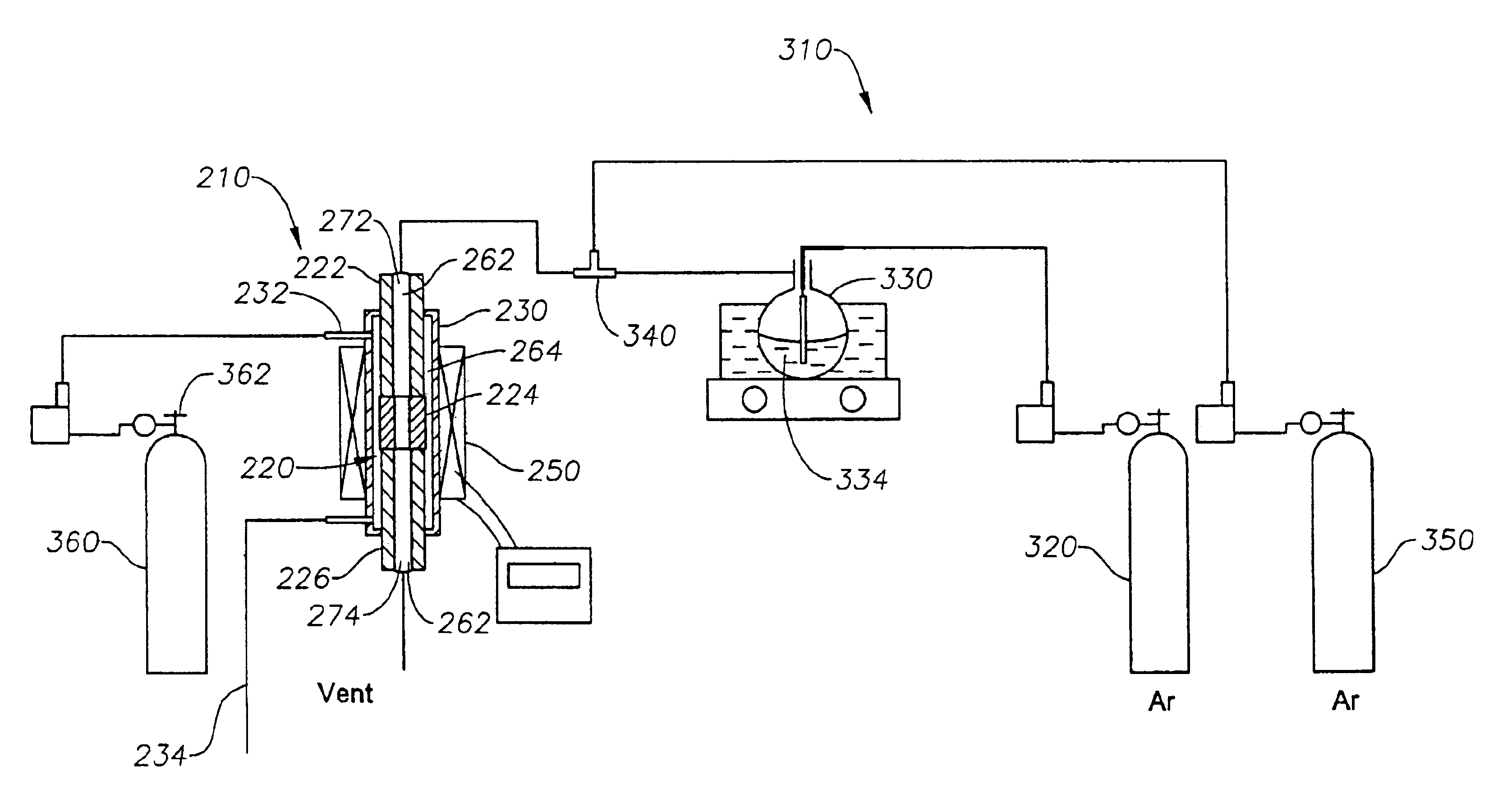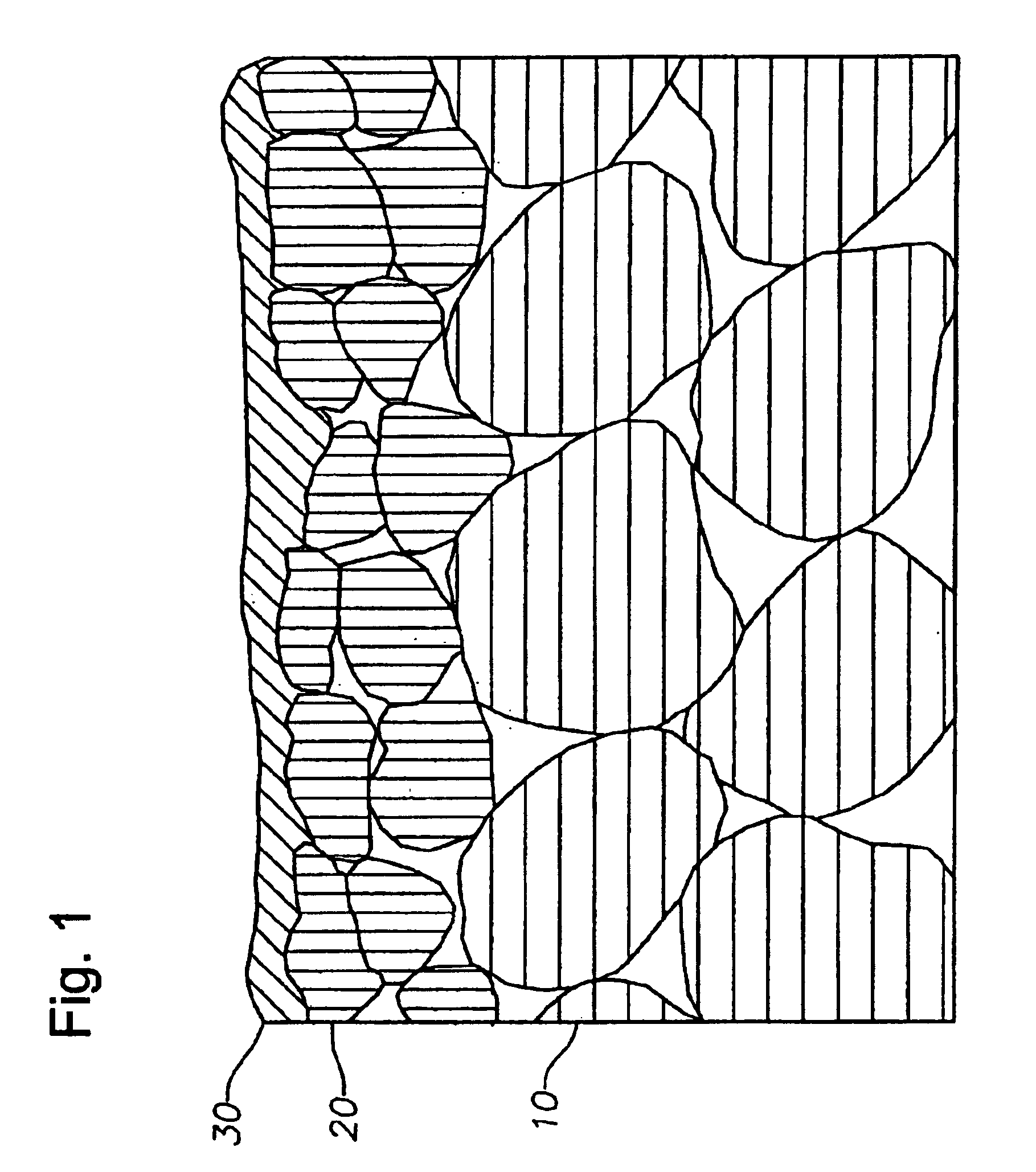Hydrogen-selective silica-based membrane
a silica-based membrane and hydrogen-selective technology, applied in the field of inorganic membranes, can solve the problems of limited conversion of methane and carbon dioxide to synthesis gas, inability to use hydrogen sulfide and ammonia in many applications, and inability to meet the requirements of synthesis conditions,
- Summary
- Abstract
- Description
- Claims
- Application Information
AI Technical Summary
Problems solved by technology
Method used
Image
Examples
example 1
The porous ceramic filter connected to dense ceramic tubing by the method described above was subjected to the deposition of a silica layer according to the CVD process described above and in PCT Patent Application PCT / US00 / 02075. CVD Recipe I on Table 1 was used. Briefly, TEOS was introduced through a bubbler using Ar as a carrier gas at 36.5 ml / min on the inner side of the tubular membrane, while a flow of Ar at 25.0 ml / min was maintained on the shell side of the reactor assembly. The deposition was conducted at 600° C. for 24 hours. Table 2 shows the hydrogen and argon permeances at 600° C. before and after the deposition. Ar, CO2, and CH4 could not be detected by gas chromatography after the CVD process. The H2 / Ar permselectivity was estimated to be more than 1,000.
TABLE 2Gas Permeation of a Ceramic Filter Before and After CVD at 600° C.Permeance (mol / m2 · s · Pa)H2ArPermselectivity H2 / ArBefore CVD4.25 × 10−59.91 × 10−64.29After CVD4.32 × 10−9Not Detectable>1000
No intermediate p...
example 2
The porous ceramic filter connected to dense ceramic tubing by the method described above was subjected to the deposition of a silica layer according to the aforementioned CVD process. First CVD Recipe I was used. TEOS was introduced through a bubbler using Ar as a carrier gas at 36.5 ml / min on the inner side of the tubular membrane, while a flow of Ar at 25.0 ml / min was maintained on the shell side of the reactor assembly. The deposition was conducted at 600° C. for 3 hours. Table 3 shows the hydrogen and argon permeances and H2 / Ar permselectivity at 600° C.
TABLE 3Gas Permeation of a Ceramic Filter Before and After CVD at 600° C.Permeance (mol / m2 · s · Pa)PermselectivityH2ArH2 / ArBefore CVD5.11 × 10−51.26 × 10−5 4.0Recipe I6.95 × 10−89.88 × 10−1070Recipe II6.68 × 10−81.01 × 10−10661.14
before and after the deposition. The hydrogen permeance decreased from 5.11×10−5 mol / m2·s·Pa to 6.95×10−8 mol / m2·s·Pa while the H2 / Ar permselectivity increased from 4 to 70. The CVD process was then re...
example 3
The porous ceramic filter connected to dense ceramic tubing by the method described above was subjected to the deposition of a silica layer according to the aforementioned CVD process. First CVD Recipe III was used. TEOS was introduced through a bubbler using Ar as a carrier gas at 4.4 ml / min on the inner side of the tubular membranes, while a flow of Ar at 25.0 ml / min was maintained on the shell side of the reactor assembly. A dilution gas of 11.7 ml / min was used, thereby decreasing the TEOS concentration from 0.112 mol / m3 to 0.03 mol / m3. Thus, CVD Recipe III and II provide identical CVD reactant concentrations in the tube side of the alumina substrate but differ in the shell environment. The deposition was conducted at 600° C. for 12 hours. Table 4 shows the hydrogen and argon permeances and hydrogen / argon permselectivity at 600° C. before and after the deposition. The hydrogen permeance decreased from 5.51×10−5 mol / m2·s·Pa to 7.90×10−8 mol / m2·s·Pa while the hydrogen / argon permsel...
PUM
| Property | Measurement | Unit |
|---|---|---|
| temperatures | aaaaa | aaaaa |
| temperatures | aaaaa | aaaaa |
| temperatures | aaaaa | aaaaa |
Abstract
Description
Claims
Application Information
 Login to View More
Login to View More - R&D
- Intellectual Property
- Life Sciences
- Materials
- Tech Scout
- Unparalleled Data Quality
- Higher Quality Content
- 60% Fewer Hallucinations
Browse by: Latest US Patents, China's latest patents, Technical Efficacy Thesaurus, Application Domain, Technology Topic, Popular Technical Reports.
© 2025 PatSnap. All rights reserved.Legal|Privacy policy|Modern Slavery Act Transparency Statement|Sitemap|About US| Contact US: help@patsnap.com



